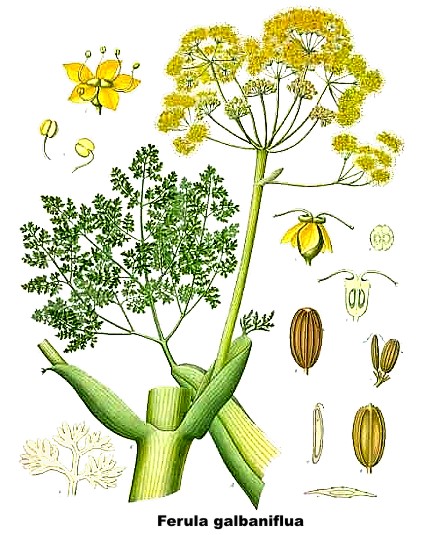Lessico
Galbano

Dal latino galbanum. Droga medicinale costituita dal latice
disseccato di alcune piante del genere Ferula![]() (Ferula galbaniflua, Ferula rubricaulis). I principi attivi sono
alcune resine, gomme e un olio essenziale.
(Ferula galbaniflua, Ferula rubricaulis). I principi attivi sono
alcune resine, gomme e un olio essenziale.
Somministrato per bocca, viene eliminato quasi integralmente per via bronco-polmonare attraverso l'aria espirata, esercitando azione prosciugante e balsamica sull'albero bronchiale. Trova impiego nelle affezioni croniche delle vie respiratorie. È anche adoperato localmente sotto forma di empiastri nelle nevralgie e contro i dolori reumatici, grazie alla sua azione revulsiva e rubefacente.
Galbanum is an aromatic gum resin, the product of certain Persian plant species, chiefly Ferula gummosa, syn. galbaniflua and Ferula rubricaulis. Galbanum-yielding plants grow plentifully on the slopes of the mountain ranges of northern Iran. It occurs usually in hard or soft, irregular, more or less translucent and shining lumps, or occasionally in separate tears, of a light-brown, yellowish or greenish-yellow colour, and has a disagreeable, bitter taste, a peculiar, somewhat musky odour, and a specific gravity of 1.212. It contains about 8% of terpene; about 65% of a resin which contains sulfur; about 20% of gum; and a very small quantity of the colourless crystalline substance umbelliferone.
Galbanum is one of the oldest of drugs. In the Book of Exodus 30:34, it is mentioned as an herb used in the making of a perfume for the tabernacle. Rabbi Shelomo ben Yitschak of the 1100s comments on this passage that galabanum is bitter and was included in the incense as a reminder of deliberate and unrepentant sinners.
It is occasionally used in the making of modern perfume, and is the ingredient which gives the distinctively unique smell to the fragrance "Must" by Cartier. Hippocrates employed it in medicine, and Pliny (Nat. Hist. xxiv. 13) ascribes to it extraordinary curative powers, concluding his account of it with the assertion that "the very touch of it mixed with oil of spondylium is sufficient to kill a serpent." The drug is occasionally given in modern medicine, in doses of from five to fifteen grains. It has the actions common to substances containing a resin and a volatile oil. Its use in medicine is, however, obsolescent.